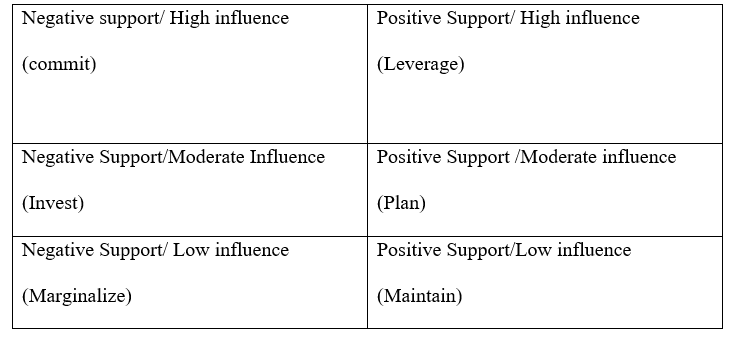Essay on Customer Satisfaction Is Critical to Any Company
Number of words: 2509
The executive summary
Customer satisfaction is critical to any company’s performance and accomplishment. A firm that meets and explores the demands of its customers is more capable of overcoming the market competition and remain resilient in the system. The main issue for the Coca-Cola Company is customer satisfaction. The corporation has recently lost clients to newer enterprises that offer similar products with slight variations. To keep solvent and retain loyal customers, the firm’s executive team must respond to customer needs quickly and adequately. Customers are regarded as the most critical and pivotal constituent of any company’s stakeholders (Omar et al,. 2016). As a result, their needs must be prioritized and addressed in a timely and adequate manner. Aside from customer satisfaction, it is also critical to consider all stakeholders’ overall well-being and satisfaction.
Strategic plans must be targeted and have a realistic number of priorities, objectives, and initiatives well stated. A sufficient amount of resources must be committed to achieving the plan’s aims and aspirations (Treen, 2012). To create the groundwork for a project’s accomplishment, the scope must be thorough, precise, and clear to team members, stakeholders, and, ideally, the entire organization. Good planning involves establishing a holistic planning approach, developing a realistic company direction for the future, and establishing good communication networks among teams. These aspects help to increase the odds of the entire business strategy being implemented successfully. As a result, this paper offers a comprehensive and intricate framework of the business proposal that seeks to address the concerns.
Purpose Statement
Organizational executives must evaluate current processes on a routine basis while collaborating with other relevant parties to implement more effective performance-improving strategies. They can use the approach to establish advancements and concerns that impede the achievement of set initiatives (Ansoff et al., 2018). A thorough examination of Coca- Cola’s mechanisms and productivity trends discloses notable disparities between anticipated and intrinsic efficiency. Earnings growth, sales, and the client satisfaction index are all critical performance indicators. The client satisfaction index dropped sharply between 2006 and 2009. This proposal will investigate the Coca-Cola Company’s customer satisfaction. The paper will use data from the company’s annual reports for the period under deliberation. It will also be essential to examine the impacts of stakeholders on efficiency. The data will be essential in developing a comprehensive solution to the problem. This scheme will influence future management actions because the executives will apply the findings and suggestions to equivalent obstacles in the long term. The proposal organizes the situation, research findings, potential solutions, stakeholder commitments, and project implementation methods.
Problem Statement
Customer satisfaction is declining significantly at the Coca-Cola Corporation. The American client sense of fulfillment index statistics is a significant source of consideration for the company’s leadership board. If they do not obtain real opportunities from Coca-products, Cola’s most customers will swap to competitors’ product lines. The corporation will lose substantial market share to competing companies in the long run due to a lack of dedicated customer groups (Ansoff et al., 2018). If sales trend patterns and earnings continue to decline, running a viable business may become impossible. The corporation’s executives should carry out a comprehensive investigation into the problem and determine the best course of action.
A variety of factors can influence customer satisfaction thresholds in any company. They include a lack of stakeholder participation and a disregard for customer feedback. In most instances, clients’ aspirations change over time. Because employees cannot exercise their decision-making skills, the control freak approach to plan implementation has been a significant impediment to increased output (Barnes, 2015). If marketing departments fail to acknowledge shifts, they will continue to manufacture goods that do not meet the needs and priorities of the target clients. Even if buyers make early purchases, the bulk of them is unlikely to stick with the brand.
Moreover, they may be reluctant to endorse the products to friends or family members (Ansoff et al., 2018). Coca-data Cola’s stakeholder involvement paints a clear picture of the problem’s underlying causes. Employees and clients have little or no influence on the success of plan execution. Employees are dissatisfied and under-productive.
The vast bulk of them have demonstrated a desire to leave because they believe their employer does not value their contributions. Such instances reduce client satisfaction because employees who are uninterested in achieving organizational goals are less concerned with aligning normal tasks with potential results. Customers may strive to acquire low-quality products as a result (Bowen & Chen, 2001). Managers hardly ever include relevant parties such as staff members and clients in decision-making processes. Consequently, organizational decisions ascertain the company’s products rather than taking into account the opinions of both workers and customers. If executives continue to exclude key stakeholders from discussions, the problem of deteriorating customer satisfaction thresholds is likely to persist.
Data and Research Findings
Management players make decisions based on credible data while carrying out daily tasks or discussing corporate issues. They must make choices based on reliable information and demonstrated leadership abilities. Coca-Cola’s revenue progress, revenue, and customer satisfaction index in the United States are depicted in the graphs below: While the American customer satisfaction index has been volatile, sales growth rates have steadily declined. Even though income values have been rising over time, they may begin to fall if customers in both established and new markets are not satisfied with the anticipated levels.
Nevertheless, the current rate of growth is 4%. The sequence suggests that the number of prospective customers and orders by customers has diminished substantially. The varying satisfaction levels indicate that the marketing team did not fully understand the purchasers’ interests and preferences. The graphs below show how sales have been trending over time due to the customer satisfaction issue and the drastic drop in sales growth rates: Coca-Cola has yet to achieve customer satisfaction stability, as shown in the graphs below.
The percentage dominance of Coca-Cola in different regions around the globe


These figures are critical in determining where Coca-Cola should expand its market reach. According to the data presented above, Coca-Cola faces stiff market competition in Latin American regions compared to other regions. The company should concentrate on revising its marketing strategies and expanding its regional markets.
The level of satisfaction is deplorable, particularly in Latin America. Management teams from various departments, such as sales and distribution, must establish the root causes of production declines. Executives from respective divisions must use their expertise to incorporate research results into strategy development and operationalization processes. As mentioned in the solution segment, pragmatic governance skills crucial in operational processes include sturdy relations with stakeholders, influencing performance breakthroughs, and problem-solving competencies.
Proposed Solution
Companies can enhance their long-term profitability by developing timely reactions after identifying the primary factors that add to the problems at hand. In this frame of reference, the report suggests a number of initiatives to boost Coca-customer Cola’s satisfaction and sales growth rates in the United States. The table below depicts a solution matrix for Starbucks’ problem:

The most significant excellent consideration is consistent dialogue, customer relationship tracking, and reasonable resource allocation as per the above statistics. As a consequence, when assigning time and resources, executives should prioritize them over other measures. They must, however, take into account each solution since they all have an impact on overall quality. To begin, the executive team must define and communicate the strategic goals to all stakeholders. They can, for instance, reassess the mission and revise the objectives. They must ensure that the objectives are specific, quantifiable, and time-bound. As a consequence, the interested parties will be well-versed in how to carry them out.
To promote communication, public discussions, the company’s annual reports, and employee training initiatives can all be utilized. Furthermore, executives should delegate duties to all involved stakeholder factions to feel like they belong to the entity. As a result, they will be highly inspired to accomplish the purpose (Ansoff et al., 2018). Lastly, to minimize differences of opinion, the managers of each division will need to establish explicit task allocation schemes. As a result, each group of employees will be designated specific tasks. Distinct duties will also encourage people to interact efficiently and to help one another produce successful performance. Individuals will be more content with the firm as a result. Additionally, the inclusion of a relationship manager will enable the corporation to pay close focus to the necessities of its customers and other stakeholders. Finally, the product will be of high quality and will conform to the preferences of the buyers.
Shareholder involvement is an essential strategy for ensuring a firm’s long viability. Top management must ascertain each interest team’s position and how it affects productivity. As a result, they can assign responsibilities to each other and ensure that they have all the necessary equipment to achieve their objectives (Ansoff et al., 2018). Workers, management, shareholders, creditors, and the government are all involved in this matter. Consumers can also assist the marketing team by communicating their wants and needs. The support of shareholders is essential, and a crucial examination is needed to identify the most impactful shareholders so that they are prioritized.
For any change to be effective, every involved stakeholder ought to be aware. The awareness of the stakeholders depends on the effectiveness of the communication strategy applied. The stakeholders who are meaningful and to the change plan but are not communicated to will rarely collaborate. Besides, the change process involves introducing new mechanisms and approaches which ought to be comprehended by the relevant personnel. These new approaches can only be incorporated, not the system, through proper communication strategies.

Employees must strive to take an influential part in putting the proposed solutions into action. They must understand the corporate strategic objectives and how they connect to their obligations. Staff members will be more engaged, and their performance will improve if top leadership maintains good relationships with customers. Employees must also work in teams to permit the sharing of ideas and well-informed solutions to challenges. The venture should be owned by the shareholders, who should share any suggestions for improving the results with the leadership team. The managers will be fully engaged in day-to-day processes while supervising employees’ practices to ensure that they align with the set goals.
Change Management Plan
The prior organizational strategy implemented in the firm was considered unproductive, particularly in terms of customer satisfaction. As a result, leadership should devise alternative approaches to addressing customer satisfaction. First, executives should directly connect the firm’s customer service desk and the clients. This will assist the company in receiving quick, straightforward, and authentic customer feedback. This feedback will assist the Coca-Cola Company in determining the root causes of the problems that customers are experiencing and quickly finding a suitable solution to this challenge (Brondoni, 2019). Aside from that, executives should conduct appropriate investigations to ascertain the appropriate customer needs and claims in the existing market system. This will assist the firm in establishing updated structures to deal with the most current market needs and patterns.
Implementation Methods
Efficient company solution execution strategies reduce the existing problem’s associated repercussions and the recurrence of related issues in the long term. Putting the explanations into action requires forming high-quality teams, effective communication, suitable working distribution, and careful planning. To obtain the best outcomes, the managerial team must identify appropriate staff clusters that can collaborate. They will need to assemble a team of workers with a wide range of skills (Ansoff et al., 2018). As a result, their efforts to carry out the treatments will enhance one another.
The team members will need to stay in touch all through the execution to motivate inter-departmental cooperation and, as a result, achieve the best results possible. Leadership will clarify each team’s obligations to mitigate confusion and allow persons to prepare for their tasks extensively. The teams will meet regularly to plan their operations, identify potential problems, and propose timely solutions. The stakeholders will evaluate achievements regularly over some time. To increase employee involvement, executives must replace micromanagement with worker empowerment initiatives. As a result, the company will gradually regain customer loyalty through detection.
Evaluating Success
It is critical to assess the success of problem-solving strategies used. The corporation and the executive will consider a variety of factors to determine the success of the strategies above. The senior management committee should ensure that the company’s communication approach is impactful. This can be accomplished by determining whether the staff understands the memos and other communication documents that have been distributed. Customer satisfaction can be considered adequate if the company gets constructive responses from its clients. Initially, coherent grievances and criticism from dissatisfied clients should now be turned into continuous complements for better good and service. Also, the management should be kept to note the mood of the workforce. A happy workforce gives an indication of the quality leadership in the firm.
Conclusion/Call to Action
Customers are the most critical stakeholders in any business. As a result, they should be prioritized when dealing with company concerns. The Coca-Cola Company had been losing many clients, and it was proven that the clients were dissatisfied with the services provided. As demonstrated in this paper, the firm must tackle customer needs to maintain customer loyalty. Among the identified solutions is an effective communication strategy that includes a quick and prompt response to customer feedback complaints. Furthermore, the firm’s governance should be improved; the top management ought to be proficient enough to resolve customer complaints.
References
Taylor, S. A., Celuch, K., & Goodwin, S. (2004). The importance of brand equity to customer loyalty. Journal of product & brand management.
Narendran, R. (2021). Unit-4 Corporate Foundations. Indira Gandhi National Open University, New Delhi.
Fang, Y. H., Chiu, C. M., & Wang, E. T. (2011). Understanding customers’ satisfaction and repurchase intentions: An integration of IS success model, trust, and justice. Internet research.
Ansoff, H. I., Kipley, D., Lewis, A. O., Helm-Stevens, R., & Ansoff, R. (2019). Diagnosing Future General Management Capability. In Implanting Strategic Management (pp. 105-125). Palgrave Macmillan, Cham.
Omar, M. S., Ariffin, H. F., & Ahmad, R. (2016). Service quality, customers’ satisfaction and the moderating effects of gender: A study of Arabic restaurants. Procedia-Social and Behavioral Sciences, 224, 384-392.
Treen, D. (2012). Overcome Why Strategic Plans Fail, for a Breakout Strategy. Trafford publishing.